Abstract
When mortality or other health outcomes attributable to fine particulate matter (PM2.5) are estimated, the same exposure–response function (ERF) is usually assumed regardless of the source and composition of the particles, and independently of the spatial resolution applied in the exposure model. While several recent publications indicate that ERFs based on exposure models resolving within-city gradients are steeper per concentration unit (μgm−3), the ERF for PM2.5 recommended by the World Health Organization does not reflect this observation and is heavily influenced by studies based on between-city exposure estimates. We evaluated the potential health benefits of three air pollution abatement strategies: electrification of light vehicles, reduced use of studded tires, and introduction of congestion charges in Stockholm and Gothenburg, using different ERFs. We demonstrated that using a single ERF for PM2.5 likely results in an underestimation of the effect of local measures and may be misleading when evaluating abatement strategies. We also suggest applying ERFs that distinguish between near-source and regional contributions of exposure to PM2.5. If separate ERFs are applied for near-source and regional PM2.5, congestion charges as well as a reduction of studded tire use are estimated to be associated with a significant reduction in the mortality burden in both Gothenburg and Stockholm. In some scenarios the number of premature deaths is more than 10 times higher using separate ERFs in comparison to using a single ERF irrespective of sources as recommended by the WHO. For electrification, the net change in attributable deaths is small or within the uncertainty range depending on the choice of ERF.
1. Introduction
Despite many years of regulations and abatement strategies, air pollution is today considered the single most important environmental health risk in Europe and globally. According to the Global Burden of Disease (GBD) assessment for 2019, ambient levels of PM2.5 (particles with an aerodynamic diameter <2.5 μm) cause around 4.1 million deaths per year [1]. The increase in risk with increased exposure is described by the exposure–response function (ERF), where a linear association is usually assumed. Using a different ERF, 8.7 million deaths were attributed solely to the fossil fuel component of PM2.5 in 2018 [2].
Influential publications by the World Health Organization (WHO) have stated that there is not enough evidence to recommend different ERFs for different particle sources [3,4]. The Health Risks of Air Pollution In Europe (HRAPIE) report recommended a hazard ratio (HR) of 1.062 per 10 μgm−3 of PM2.5 for health impact assessments (HIA) of all-cause mortality at age >30 years [4]. This recommendation was based on a meta-study [5], and was heavily influenced by epidemiological studies based on differences in concentrations between different cities.
Higher risk estimates per increase in mass concentration for soot particles (including black carbon) than for PM2.5 have before been reported in meta-analyses of published studies [5,6]. These observations suggest strong effects from primary combustion-related particles, e.g., vehicle exhaust particles, per increase in mass concentration. However, the limited number of studies on PM2.5 elemental components have produced rather inconclusive results regarding which components are most important for mortality, perhaps because elements such as Fe, Zn, and K may represent different sources in different places [7].
Most HIAs dealing with air pollution levels (including national studies) [8,9] have focused on particles, whereas some local assessments considered ERFs for NOx or NO2 as more relevant for traffic emissions than the ERFs for total PM2.5 from older studies with between-city comparisons [10,11,12]. Older epidemiological studies on the associations between total PM exposure and mortality did not provide any alternatives. In some HIAs the authors were concerned about the choice of one single exposure–response function for both the regional background exposure and the contribution of PM from local sources, and stressed the need for studies with a higher spatial resolution [8]. In other assessments it was concluded that the application of ERFs from studies using central monitors results in an underestimation of health impacts [13].
A HIA or a cost–benefit analysis based on a regional HR that severely underestimates the benefits of reducing local emissions would discourage cities from implementing local abatement strategies. The aim of this study was to investigate how critical the choice of ERF is when evaluating traffic-related abatement strategies. We studied this by comparing the potential health benefits of three viable abatement strategies for road traffic in Stockholm and Gothenburg. We also provided an example of how an HIA can be designed that uses different risk estimates for PM2.5 originating from local sources and long-range transport, as well as from exhaust and non-exhaust traffic emissions.
2. Materials and Methods
2.1. Population Exposure
Population exposure to PM in ambient air was estimated in Stockholm and Gothenburg, the largest and the second largest cities in Sweden, respectively. The contributions to PM2.5 from local source categories were described using high/resolution Gaussian dispersion modeling, while the contribution from long-range transport (LRT) was estimated based on monitoring data. Near roads, concentrations were modeled with a resolution down to 50 × 50 m2. Dispersion from more diffuse sources and at a longer distance was described at lower resolution. Further details on the dispersion modeling and emission inventories involved, including evaluation against measurements, can be found in Segersson et al. [14].
The current HIA was developed within an area of 35 × 35 km2 around the center of each of the 2 cities (see Figure 1). Exposures originating from local sources were divided into the following source categories:
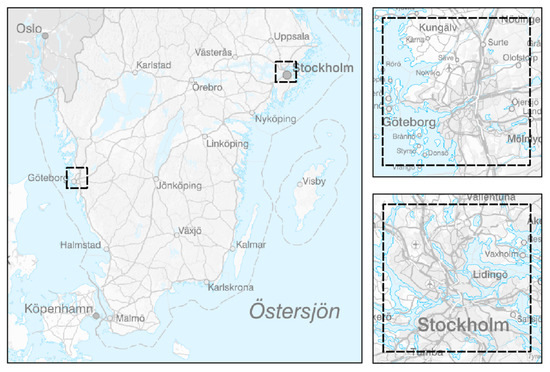
Figure 1.
Modeling areas of 35 × 35 km2. An overview is displayed on the left; zoomed in maps are shown for Gothenburg (upper right) and Stockholm (lower right).
- Residential wood combustion (RWC);
- Road traffic (exhaust);
- Road traffic (wear);
- Shipping;
- Other local sources.
No corresponding division into source categories was made for LRT. As an example, the annual average concentration of PM2.5 for 2011, which was used as the baseline for scenario calculations, is presented in Figure 2. Population-weighted concentrations are provided per source category in Table 1.
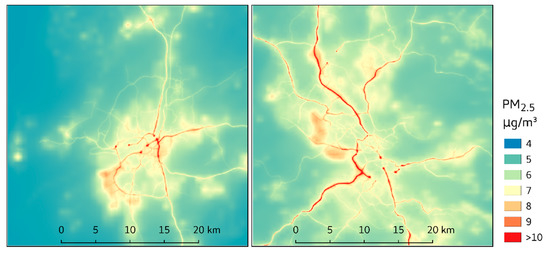
Figure 2.
Yearly average concentrations of PM2.5 during the baseline year 2011 in Gothenburg (left) and Stockholm (right) [14].

Table 1.
Population-weighted concentrations for the baseline year 2011 and population aged > 30 years [14].
2.2. Abatement Strategies
Effects of different abatement strategies were estimated by modifying source-specific contributions to PM concentrations in proportion to the estimated change in emissions. The evaluated abatement strategies consisted of the introduction of congestion charges, the reduced use of studded tires, and the electrification of light vehicles.
2.2.1. Introduction of Congestion Charges
In Stockholm, a congestion charge was introduced in 2007. The system consists of a toll cordon around the inner city. A few months after the introduction, the traffic reduction across the cordon stabilized at 20–22% [15]. In Gothenburg a similar cordon-based congestion charge was introduced in 2013. The observed traffic reduction across the cordon was 10% on average [16]. For simplicity, the effect of the congestion taxes is represented by an overall reduction in traffic flow within the modelling areas of 21% and 10% for Stockholm and Gothenburg, respectively. Both exhaust and wear emissions (road, tire, and brake wear) are considered proportional to the traffic flow. Since the congestion charges in Stockholm were introduced before the baseline year of 2011, the effect of the congestion charges was determined in this case with ex-post estimations. In Table 2, estimated changes in emissions due to the congestion charges and resulting changes in population exposure are presented.

Table 2.
Estimated changes in population-weighted concentrations due to introduction of congestion charges. For Stockholm, the ex-post change is given, i.e., assuming the congestion charge in Stockholm had not been introduced before the baseline year. In the table header, “% of total” refers to total concentration in ambient air.
2.2.2. Reduced Use of Studded Tires
Studded tires are used during winter in order to increase the grip between the tires and the road, and thus reduce the number of accidents. The road wear due to the use of studded tires is an important contributor to PM2.5 and PM10 in cities of Nordic countries [10,17,18]. In general, use of studded winter tires is allowed in Sweden between 1 October and 15 April. However, some cities where PM10 levels are high have banned the use of studded tires on a few streets in order to reduce the overall usage in the cities. In Stockholm 3 streets have a ban and in Gothenburg there is a ban on 2 streets. Both cities promote citizens to use non-studded winter tires and a significant reduction in the share of studded winter tires can be seen.
In Hornsgatan, Stockholm, the maximum share of vehicles using studded tires was reduced from 70% to 36% immediately after the ban and further to below 30% in later years. The combined effect of all emission sources and meteorological factors showed a reduction of around 50% in the street PM10 concentration increment averaged for October to May over the years 2011–2014 with the ban in place [18]. If considering the entire year, the reduction would be smaller. To account for this, we assumed that the local road wear emissions over the whole year were reduced by 35% due to studded tire restrictions in both Stockholm and Gothenburg. The road wear was assumed to constitute 75% of the total traffic related wear (road, brake, and tire) and to mainly (around 90%) consist of particles with a diameter >2.5 μm [17]. The estimated changes in emissions and resulting change in population exposure are presented in Table 3.

Table 3.
Estimated changes relative to baseline due to reduced use of studded tires. In the table header, “% of total” refers to the total concentration in ambient air.
2.2.3. Electrification of Light Vehicles
Many countries have proposed ambitious policies to reduce greenhouse gas emissions by encouraging a transformation towards a fossil-free vehicle fleet. Stockholm city has set a target to be completely fossil-free by 2040. The plans also include implementation of local environmental zones from which vehicles running on fossil fuels will be banned [19]. We represented this strategy by assuming that 50% of all light vehicles within the modelling area are electrified. The same strategy was also applied in Gothenburg. Exhaust emissions are obviously reduced to zero for electric vehicles, but non-exhaust particles from road, tire, and brake wear are also expected to change. This has been overlooked in some previous studies [20,21], leading to overly optimistic expectations on air quality improvements due to electrification. While particle emissions from brake wear are expected to decrease due to use of regenerative braking systems, road and tire wear emissions are likely to increase due to the higher weight of the electric vehicles. The road and tire wear emissions are assumed proportional to weight [22]. A new electric vehicle is expected to weigh 25% more than a corresponding vehicle with a combustion engine [23]. A reduction by 30% is assumed for brake wear emissions [23]. In countries with cold winters, the increase of road wear is also affected by the use of studded tires. In this scenario, the fraction of electric vehicles using studded tires was the same as for light vehicles in the baseline fleet. Brake wear is assumed to contribute 20% of PM2.5 wear emissions and 1% of PM2.5–10 wear emissions; the rest of the wear emissions are caused by road and tire wear [17]. Assumptions related to change in wear emissions are summarized in Table 4 and the changes in emissions and population exposure are presented in Table 5.

Table 4.
Assumptions and estimations made to calculate change in emissions for a scenario with 50% electrification of light vehicles.

Table 5.
Estimated changes relative to baseline due to electrification of 50% of light vehicles.
2.3. Health Impact Analysis
The evaluation of health impact follows the impact pathway chain [24] presented in Figure 3. Using source-specific exposure estimates, the number of premature deaths was attributed to different emission sectors (see Table 1).
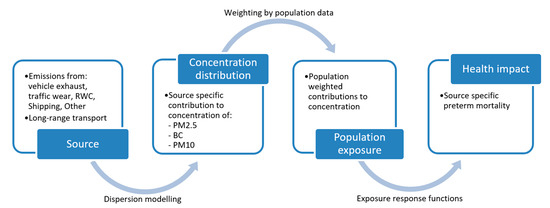
Figure 3.
Health impact assessment following the impact pathway chain.
Calculations were performed for the baseline in 2011 as well as for the 3 abatement strategies. Monte Carlo simulations were used to estimate the uncertainty range of number of premature deaths (see supplementary S1 for source code). When aggregating uncertainties related to the different sources, the different ERFs were assumed to be independent. The margin of error for exposure estimates was assumed to be 20%. The baseline mortality for natural deaths representing the baseline year was acquired from the Swedish Cause of Death Register at The National Board of Health and Welfare.
In addition to the ERF for PM2.5 and mortality recommended by WHO, there is a growing number of alternative assumptions. Data from the very large American Cancer Society’s (ACS) Cancer Prevention Study II (CPS-II) have been used in many influential studies of PM2.5 concentrations and mortality, where most studies have used monitor data and described associations of metropolitan-level air pollution (“between-city contrasts”) and mortality [25,26]. In those studies, for many years dominating assessments of PM2.5 effects, exposure data were derived at the metropolitan scale, relying on central monitor data. The increase HR in natural mortality using between-city contrasts in PM2.5 has been estimated around 1.06 % per 10 µgm−3. However, Jerrett et al. [27] also used the ACS CPS-II data but constructed small-area exposure measures (using zip-code) in Los Angeles, California, by interpolation from 23 PM2.5 monitors and observed effects nearly 3 times greater than in the models relying on comparisons between communities.
Turner et al. [28] studied 669,046 participants from the ACS Cancer Prevention Study CPS -II with PM2.5 concentrations estimated using a national-level hybrid land use regression and Bayesian maximum entropy interpolation model. Estimates of PM2.5 were decomposed into near-source and regional components. Ozone and nitrogen dioxide concentrations were also modeled and included in the analyses. In the multi-pollutant model, the hazard ratio (HR) per 10 µgm−3 for regional PM2.5 became 1.04 (1.02–1.06), whereas for near-source PM2.5 it was 1.26 (1.19–1.34).
In a cohort of 635,539 individuals from the US National Health Interview Survey (NHIS), Lefler et al. [29] studied whether the PM2.5–mortality relationship differs according to scale of spatial variability. Modeled air pollution exposure estimates for PM2.5, other criteria air pollutants, and spatial decompositions (<1 km, 1–10 km, 10–100 km, >100 km) of PM2.5 were assigned at the census tract-level. PM2.5 mass was largely composed of regional and mid-range components, likely most secondary particles, while the neighborhood and local components contributed a relatively small fraction of PM2.5 (23%). The PM2.5–mortality association was observed across all 4 spatial scales of PM2.5, with higher but less precisely estimated HRs observed for local (<1 km) and neighborhood (1–10 km) variations, scaled by 10 µgm−3 1.299 (95% CI 1.014–1.664) and 1.279 (95% CI 1.173–1.395), respectively, from a joint model with all 4 scales. In a 2-pollutant model with total PM2.5 and PM2.5–10, the all-cause mortality HR associated with a 10 μgm−3 increase in PM2.5 was 1.12 (95% CI 1.09–1.15), whereas the HR associated with a 10 μgm−3 increase in PM2.5–10 was 1.02 (95% CI 1.00–1.04). In the most complex model with total PM levels (with no decompositions), the HR for an IQR increase in PM2.5 (3.12) was 1.045 (95% CI 1.030–1.061) and in PM2.5–10 it was 1.025 (95% CI 1.011–1.038) per IQR (5.43). This corresponds for the coarse fraction to 1.05 (95% CI 1.02–1.07) per 10 µgm−3, and for PM2.5 to 1.15 per 10 µgm−3.
Spatial variation in particle levels within urban areas is commonly caused by local traffic emissions. When a meta-regression technique was used to investigate the heterogeneity between the studies and whether the study population or analytic characteristics modified the association between PM2.5 and mortality, Vodonos et al. [30] found that geographical locations with higher percent of PM2.5 coming from traffic were significantly associated with higher estimates with and an HR 1.0205 (95% CI 1.0189–1.0181) per μgm−3.
Published reviews often present quantitative summaries of effect size as estimated across studies regardless of the many differences in exposure levels and exposure assessment methods. However, the meta-regression technique used by Vodonos et al. [30] described based on 53 studies with 135 estimated how the PM2.5 coefficient decreased in a manner inversely proportional to the mean concentration, and when restricted to studies with mean concentrations below 10 μg/m3, the meta-regression estimated an HR of 1.024 (95% CI 1.008–1.04) per 1 μgm−3. Less error-prone exposure assessments and greater control for socioeconomic status were also factors associated with larger effect size estimates. Non-linear ERFs which level off at high concentrations have also been suggested when examining the shape of the association between PM2.5 and non-accidental mortality applied in the Global Burden of Disease Study [31]. The resulting Global Exposure Mortality Model (GEMM) builds on data from 41 cohorts from 16 countries but does not consider differences between exposure measures or particle sources.
It is becoming more and more apparent that the risk increase per µgm−3 PM2.5 is greater in areas with low total PM2.5 concentrations, for local source contribution, and for traffic emissions than for regional PM2.5. Meta-regressions showed that studies with more accurate exposure assessment methods reported larger effect size estimates for PM2.5 [32]. Furthermore, within large cohorts the scale of spatial variability in concentrations is important for estimated mortality HRs. Turner et al. [28] observed a more than six times higher HR per absolute increase in concentration for near-source PM2.5 in comparison with regional PM2.5. Lefler et al. [29] found similar patterns and concluded that regressions using spatially decomposed PM2.5 suggest that more spatially variable components of PM2.5 may be more toxic. Traffic [30] and low PM2.5 exposure [30,32] are factors associated with high HRs. The HR estimated for PM2.5 and natural mortality in the Swedish SCAC study [33] falls in the same range as reported by others with exposure variability driven by local sources and is based on the same exposure modeling as this health impact analysis (HIA). Many studies have concluded that there is no evidence of a threshold and that no safe level of PM can be determined [4]. Some assessments have included a threshold to reflect insufficient data at low total concentrations. For this reason, a cut-off of 2 μgm−3 for LRT PM2.5 was applied, corresponding to the lowest exposure level with significant associations [5], whereas no cut-off was applied for the anthropogenic local contributions.
Based on the above-mentioned literature, 3 different approaches for the HIA are compared:
- WHO standardThe same 1.08 (CI 95% 1.06–1.09) HR [32] is applied for PM2.5 regardless of source and origin of the particles;
- Separation by distance to sourceHRs based on near-source and regional decompositions [28] are applied to local contributions and LRT, respectively;
- Separation by source category and distanceSame approach as B., but using an HR for black carbon (BC) [33] to represent vehicle exhaust PM and an HR for PM10 [33] to represent vehicle wear PM.
In approach B, different HRs are applied for near-source and long-range (regional) contributions to PM2.5. In Figure 4, HRs from previously mentioned studies have been labeled according to the spatial resolution of the exposure data on which they are based, showing a clear tendency of higher risk estimates for within-city contributions to PM2.5. An overview of the different HRs can be found in Table A1. The study by Sommar et al. [33] is based on the same exposure data as in this study. However, Turner et al. [28] reported an HR for near-source PM2.5 with a very similar value but a smaller uncertainty range and presented an HR for regional PM2.5. Furthermore, the HR from Turner et al. was adjusted for NO2 and ozone. Therefore, the mortality HRs 1.26 (CI 95% 1.19–1.34) and 1.04 (CI 95% 1.02–1.06) reported by Turner et al. per 10 μgm−3 were used for the local and regional contribution to PM2.5, respectively.
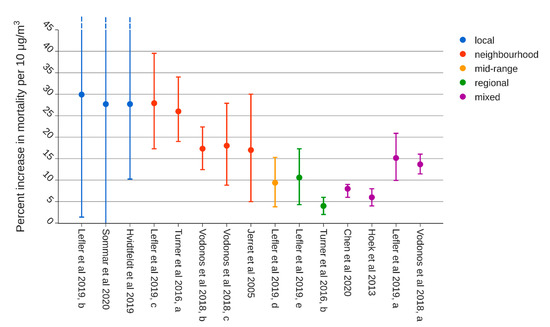
Figure 4.
Percent increase in mortality per 10 µgm−3 PM2.5 categorized by spatial resolution of exposure data. “Local” corresponds to <1 km resolution, “neighborhood” to 1–10 km, “mid-range” to 10–100 km, and “regional” to >100 km. Confidence intervals (95%) are shown as dashed where outside the scale. In the figure, the estimate denoted as “near-source” by Turner et al. [28] is categorized as the neighborhood scale. The data presented in the figure can be found in Table A1.
Since only PM2.5 was used as an indicator in approach A and B, changes in coarse PM (larger than 2.5 μm) were not reflected at all in the calculated health effects. This is problematic when evaluating abatement scenarios including significantly larger changes in exposure to coarse PM than to PM2.5. In approach C, coarse PM was also included when estimating the impact by using PM10 as an indicator for road wear PM with a HR by Sommar et al. [33]. Furthermore, in this approach BC was used instead of PM2.5 to estimate health effects related to vehicle exhaust. Since local emissions from vehicle exhaust are an important, often dominating, source of BC in urban areas [34], this choice of indicator is more specific for vehicle exhaust than using HR based on bulk PM2.5. The study by Sommar et al. [33] was used since it includes the same geographical areas as this assessment and is based on exposure data with “within-city” contrasts resolved. For other sources of PM than road traffic, the same HR as in approach B was used.
3. Results
3.1. Evaluation of Abatement Strategies
Relative changes in number of premature deaths due to traffic air pollution for the three abatement strategies are presented in Figure 5. According to approach A (WHO standard), all three abatement strategies have low potentials in reducing mortality related to air pollution by at most 2%. When considering differences in HR for near-source and long-range contributions to PM2.5 (approach B), the associated mortality is reduced by up to 8%. When choosing indicators more representative for traffic-related air pollution (approach C), the associated mortality is reduced by up to 14%. Evidently, the choice of ERF is a critical factor when evaluating local abatement strategies.
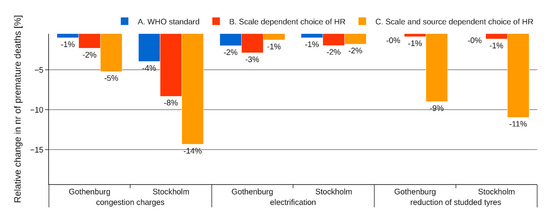
Figure 5.
Relative change in mortality attributed to traffic air pollution for the 3 abatement strategies applied in Gothenburg and Stockholm, using 3 different HIA approaches.
For the introduction of congestion charges, the differences between Stockholm and Gothenburg seen for all three HIA approaches in Figure 5 are mainly caused by differences in the observed traffic reduction in the two cities. The differences for the other two abatement strategies are caused by minor differences in the baseline related to vehicle fleet composition, share of PM2.5 in wear PM, and share of studded tires.
3.2. Source-Specific Change in Mortality
The absolute change in the attributed mortality is presented separately for different sources in Figure 6, Figure 7 and Figure 8.
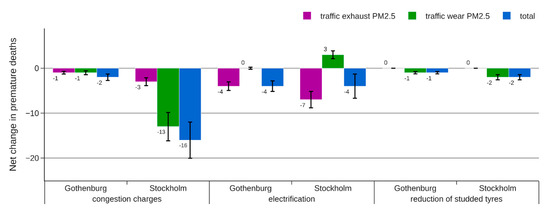
Figure 6.
Estimated change in number of premature deaths for each of the abatement strategies following approach A (“WHO standard”). The error bars represent a 95% CI.
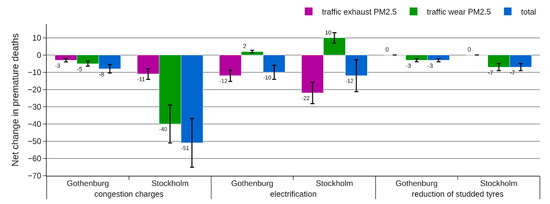
Figure 7.
Estimated change in number of premature deaths for each of the abatement strategies following approach B (separation by distance to source). The error bars represent a 95% CI.
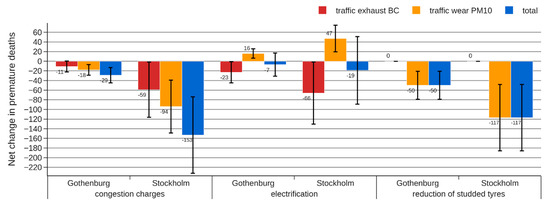
Figure 8.
Estimated change in number of premature deaths for each of the abatement strategies following approach C (separation by source category and distance). The error bars represent a 95% CI.
For the electrification strategy, the increased road wear emissions to some extent compensate for the reduced exhaust emissions, resulting in a modest net reduction in attributed mortality. All HIA approaches indicate an effect in the range of −4 to −19 premature deaths, but the 95% CI of approach C is wider, indicating a possible increase in attributed mortality when the effect of coarse PM is considered in the analysis.
For a reduction of studded tires, approach A (“WHO standard”) and approach B (“Separation by distance to source”) indicate a very small reduction in air pollution-related mortality. The reason is that PM from road wear with a diameter >2.5 μm is not included in the indicator used in these approaches. Since around 90% of wear PM in Stockholm and Gothenburg has a diameter >2.5 μm, there is a risk of almost completely missing any health benefits from this abatement strategy using approach A or B. Approach C instead uses PM10 as an indicator for this source resulting in an estimated reduction in premature deaths that is 17–59 times greater.
The introduction of congestion charges reduces both exhaust and non-exhaust emissions and affects all vehicle types, resulting in significant health benefits according to all three HIA approaches. However, the change in attributed mortality is very different for the three HIA approaches, resulting in −16, −51, and −153 premature deaths for approaches A, B, and C, respectively.
4. Discussion
The optimal situation for a HIA would be to apply an ERF which is estimated using the same sources, exposure measures, and population as the impact assessment concerns. This suggests that recent studies from the same region are of special value, at least if they are based on a large cohort and offer precise estimates. In real situations it may be realistic to use the most relevant studies with respect to sources and exposure variables.
Long-range transported PM2.5 represents around 60–70% of the urban background PM2.5 concentration in the largest Swedish cities, but is likely not that dominant when it comes to health impacts. We suggest using a different ERF for near-source PM2.5 than for LRT. This is supported by many observations of within-city variations in concentrations (local sources), with traffic emissions and low exposure levels being associated with steeper ERFs. The generally higher HRs observed in populations with low concentrations could likely be explained by a low regional background concentration showing small geographic variability and thus a larger proportion of the variation in exposure explained by local sources.
Non-exhaust emissions are expected to constitute a more and more dominant source of traffic-generated PM2.5 in the future [35]. Even though regenerative braking in electric vehicles may reduce brake wear emissions, tire and road wear are likely to increase due to the heavier weight of the electric vehicles that are becoming more common. We assume the same ERF for exhaust and non-exhaust PM2.5. Many epidemiological studies make use of PM exposure data based on monitoring data or land-use regression (LUR) [36]. These methods do not in general allow source attribution, making it impossible to distinguish non-exhaust from exhaust PM. While dispersion modeling does allow source attribution, exhaust and non-exhaust PM are highly correlated, making it challenging to separate observed health effects from the two sources statistically. If traffic wear particles in the fine fraction correspond to a smaller HR than those estimated for local sources totally, then the HR for PM2.5 from combustion (vehicle exhaust) must be higher than the estimated HR. This has not been shown, and the results from studies of sources and components are not very consistent [37]. However, in Sweden the association with daily mortality has been stronger for road dust and the coarse fraction than for fine PM, NO2, and particle number concentration [38,39].
There are several possible explanations as to why near-source PM2.5 results in steeper ERFs. Near-source PM2.5 contains a larger fraction of particles from traffic and local combustion, while LRT includes more secondary aerosols and particles from natural sources such as sea salt. The LRT aerosol has also spent a longer time in the atmosphere, with aging processes [40] modifying the particles properties. The oxidative potential of PM has been suggested as one of several possible drivers of acute health effects of PM, although the link remains uncertain [41]. PM from anthropogenic sources typically has higher oxidative potential in comparison to secondary aerosols and the crustal material that often dominates the total PM mass concentration [41]. Spatial contrasts within a city or a county are much stronger in near-source PM2.5 exposure than in LRT PM2.5 exposure. Not resolving these spatial contrasts leads to misclassification of exposure, especially for the most (and least) exposed individuals, which is likely to affect epidemiological analysis. There are probably also differences in the ability to control for confounding between studies with ERFs based on within-city (near-source) and between-city (LRT) exposure contrasts. Epidemiological studies for near-source exposure may be carried out within relatively small geographical areas, thereby reducing the risk of variations in the population and the relevance of covariates adjusted for in the analysis.
We only applied a low threshold for LRT PM2.5 in our calculations. The existence of a low threshold has become less and less supported (e.g., the EEA presented mortality impact estimates for PM2.5 without using any threshold). In the review for the WHO AQG update, an analysis restricted to studies with a mean exposure below that of the current guideline (10 μgm−3) resulted in a steeper combined ERF, and the authors concluded that if a threshold is present, it is at very low levels [32]. It should be noted that for an analysis not using any threshold for LRT PM2.5, the total estimated number of premature deaths would have been greater and the relative importance of local sources smaller.
5. Conclusions
Among the three evaluated abatement strategies, the largest effect was seen for the reduction of studded tires and using separate ERF for exhaust and non-exhaust sources. However, this was heavily dependent on the choice of ERF applied for coarse PM generated by road wear. The introduction of congestion charges, implying overall traffic reduction, is a safer choice of strategy, and is almost as efficient when health benefits from the reduction of coarse wear PM are considered. This strategy results in a significantly reduced number of premature deaths, except for when the “WHO standard” approach is used, resulting in a reduction of the number of premature deaths within the uncertainty range. The electrification of light vehicles showed a surprisingly low potential to reduce premature mortality, resulting in a small or even insignificant reduction in attributed mortality depending on the choice of ERF.
When estimating premature mortality due to PM2.5 exposure, we strongly suggest that different ERFs be applied for near-source and long-range PM2.5 exposure. The ERF for PM2.5 recommended by the WHO [32] is heavily influenced by epidemiological studies based on between-city (long-range) exposure assessments. Applying a single “average” ERF, as recommended by WHO, therefore results in an underestimation of effects from local measures, effectively sending the message that local measures do not matter.
When the same risk ratio is used to describe both vehicle exhaust and traffic wear PM, wear PM dominates the health impact in Nordic cities. Exhaust PM is sometimes assumed to be more toxic than wear PM. Not reflecting this in the analysis results in a bias towards abatement strategies focusing on PM wear particles. It is difficult to separate effects of exhaust and wear PM in epidemiological studies due to the high correlation between the two variables. Furthermore, ERFs for coarse PM based on multi-pollutant models may to some extent include the effect of exhaust PM (and vice versa). If exhaust PM is assumed to be more toxic than wear PM, an ERF for BC is preferable. BC is not as “diluted” by wear particles and more dominated by vehicle exhaust, making it more representative for this source.
Using HIA to support decisions regarding abatement strategies in cities requires careful consideration regarding the choice of ERF. Applying a single average ERF for different source categories may be misleading in the same way as for near-source and long-range PM2.5 exposure. Future epidemiological studies based on source specific exposure estimates can potentially allow the separation of health effects from exhaust and non-exhaust PM as well as from other important urban emission sources.
Supplementary Materials
The following are available online at https://www.mdpi.com/article/10.3390/ijerph18136847/s1, Source code and data for HIA S1.
Author Contributions
Conceptualization, B.F.; Data curation, D.S.; Formal analysis, D.S.; Funding acquisition, B.F.; Methodology, D.S., C.J. and B.F.; Software, D.S.; Supervision, C.J.; Visualization, D.S.; Writing—original draft, D.S., C.J. and B.F.; Writing—review and editing, C.J. and B.F. All authors have read and agreed to the published version of the manuscript.
Funding
This study forms part of the Swedish Clean Air & Climate Research program, funded by the Swedish Environmental Protection Agency, and of the NORDUST project financed by the Swedish Transport Administration within the framework of NordFoU.
Institutional Review Board Statement
Not applicable.
Informed Consent Statement
Not applicable.
Data Availability Statement
Data is contained within the article or supplementary material.
Conflicts of Interest
The authors declare no conflict of interest. The funders had no role in the design of the study; in the collection, analyses, or interpretation of data; in the writing of the manuscript, or in the decision to publish the results.
Appendix A

Table A1.
HR for all-cause mortality per 10 μgm−3 PM2.5 categorized according to spatial resolution of the exposure data. “Local scale” represents spatial resolution <1 km, “neighborhood” 1–10 km, mid-range 10–100 km, and “regional” >100 km.
Table A1.
HR for all-cause mortality per 10 μgm−3 PM2.5 categorized according to spatial resolution of the exposure data. “Local scale” represents spatial resolution <1 km, “neighborhood” 1–10 km, mid-range 10–100 km, and “regional” >100 km.
| Reference | Spatial Scale | HR |
|---|---|---|
| Chen et al. [32] | mixed | 1.08 (1.06–1.09) |
| Hoek et al. [5] | mixed | 1.06 (1.04–1.08) |
| Lefler et al. [29], a | mixed | 1.15 (1.10–1.21) |
| Lefler et al. [29], b | local | 1.30 (1.10–1.66) |
| Lefler et al. [29], c | neighborhood | 1.28 (1.17–1.40) |
| Lefler et al. [29], d | mid-range | 1.09 (1.04–1.15) |
| Lefler et al. [29], e | regional | 1.11 (1.04–1.17) |
| Turner et al. [28], a | local | 1.26 (1.19–1.34) |
| Turner et al. [28], b | regional | 1.04 (1.02–1.06) |
| Vodonos et al. [30], a | mixed | 1.14 (1.11–1.16) 1 |
| Vodonos et al. [30], b | neighborhood | 1.17 (1.12–1.22) 1,2 |
| Vodonos et al. [30], c | neighborhood | 1.18 (1.19–1.28) 1,3 |
| Sommar et al. [33] | local | 1.28 (−0.83–1.96) |
| Hvidtfeldt et al. [42] | local | 1.28 (1.10–1.46) |
| Jerret et al. [25] | neighborhood | 1.17 (1.05–1.30) |
1. at 10 μgm−3. 2. representative for space–time hybrid models [30]. 3. representative for exposure estimates using zip-code level monitoring stations [30].
References
- GBD 2019 Risk Factors Collaborators. Global burden of 87 risk factors in 204 countries and territories, 1990–2019: A systematic analysis for the Global Burden of Disease Study 2019. Lancet 2020, 396, 1223–1249. [Google Scholar] [CrossRef]
- Vohra, K.; Vodonos, A.; Schwartz, J.; Marais, E.A.; Sulprizio, M.P.; Mickley, L.J. Global mortality from outdoor fine particle pollution generated by fossil fuel combustion: Results from GEOS-Chem. Environ. Res. 2021, 195, 110754. [Google Scholar] [CrossRef] [PubMed]
- World Health Organization (Ed.) Air Quality Guidelines: Global Update 2005: Particulate Matter, Ozone, Nitrogen Dioxide, and Sulfur Dioxide; World Health Organization: Copenhagen, Denmark, 2006; ISBN 978-92-890-2192-0. [Google Scholar]
- Health Risks of Air Pollution in Europe–HRAPIE Project. Recommendations for Concentration–Response Functions for Cost–Benefit Analysis of Particulate Matter, Ozone and Nitrogen Dioxide; WHO Regional Office for Europe: Copenhagen, Denmark, 2013. [Google Scholar]
- Hoek, G.; Krishnan, R.M.; Beelen, R.; Peters, A.; Ostro, B.; Brunekreef, B.; Kaufman, J.D. Long-term air pollution exposure and cardio- respiratory mortality: A review. Environ. Health 2013, 12, 43. [Google Scholar] [CrossRef] [PubMed] [Green Version]
- Janssen, N.A.; Hoek, G.; Simic-Lawson, M.; Fischer, P.; Van Bree, L.; ten Brink, H.; Keuken, M.; Atkinson, R.W.; Anderson, H.R.; Brunekreef, B.; et al. Black Carbon as an Additional Indicator of the Adverse Health Effects of Airborne Particles Compared with PM10and PM2.5. Environ. Health Perspect. 2011, 119, 1691–1699. [Google Scholar] [CrossRef] [PubMed] [Green Version]
- Chen, J.; Rodopoulou, S.; de Hoogh, K.; Strak, M.; Andersen, Z.J.; Atkinson, R.; Bauwelinck, M.; Bellander, T.; Brandt, J.; Cesaroni, G.; et al. Long-Term Exposure to Fine Particle Elemental Components and Natural and Cause-Specific Mortality—A Pooled Analysis of Eight European Cohorts within the ELAPSE Project. Environ. Health Perspect. 2021, 129, 47009. [Google Scholar] [CrossRef]
- Forsberg, B.; Hansson, H.-C.; Johansson, C.; Areskoug, H.; Persson, K.; Järvholm, B. Comparative Health Impact Assessment of Local and Regional Particulate Air Pollutants in Scandinavia. Ambio 2005, 34, 11–19. [Google Scholar] [CrossRef]
- Fann, N.; Coffman, E.; Timin, B.; Kelly, J.T. The estimated change in the level and distribution of PM2.5-attributable health impacts in the United States: 2005–2014. Environ. Res. 2018, 167, 506–514. [Google Scholar] [CrossRef]
- Johansson, C.; Burman, L.; Forsberg, B. The effects of congestions tax on air quality and health. Atmos. Environ. 2009, 43, 4843–4854. [Google Scholar] [CrossRef]
- Orru, H.; Lövenheim, B.; Johansson, C.; Forsberg, B. Potential health impacts of changes in air pollution exposure associated with moving traffic into a road tunnel. J. Expo. Sci. Environ. Epidemiol. 2015, 25, 524–531. [Google Scholar] [CrossRef] [Green Version]
- Brønnum-Hansen, H.; Bender, A.M.; Andersen, Z.J.; Sørensen, J.; Bonlokke, J.H.; Boshuizen, H.; Becker, T.; Diderichsen, F.; Loft, S. Assessment of impact of traffic-related air pollution on morbidity and mortality in Copenhagen Municipality and the health gain of reduced exposure. Environ. Int. 2018, 121, 973–980. [Google Scholar] [CrossRef]
- Haluza, D.; Kaiser, A.; Moshammer, H.; Flandorfer, C.; Kundi, M.; Neuberger, M. Estimated health impact of a shift from light fuel to residential wood-burning in Upper Austria. J. Expo. Sci. Environ. Epidemiol. 2012, 22, 339–343. [Google Scholar] [CrossRef]
- Segersson, D.; Eneroth, K.; Gidhagen, L.; Johansson, C.; Omstedt, G.; Nylén, A.E.; Forsberg, B. Health Impact of PM10, PM2.5 and Black Carbon Exposure Due to Different Source Sectors in Stockholm, Gothenburg and Umea, Sweden. Int. J. Environ. Res. Public Health 2017, 14, 742. [Google Scholar] [CrossRef] [PubMed] [Green Version]
- Börjesson, M.; Eliasson, J.; Hugosson, M.B.; Brundell-Freij, K. The Stockholm congestion charges—5 years on. Effects, acceptability and lessons learnt. Transp. Policy 2012, 20, 1–12. [Google Scholar] [CrossRef]
- West, J.; Börjesson, M. The Gothenburg congestion charges: Cost–benefit analysis and distribution effects. Transportation 2018, 47, 145–174. [Google Scholar] [CrossRef] [Green Version]
- Denby, B.; Sundvor, I.; Johansson, C.; Pirjola, L.; Ketzel, M.; Norman, M.; Kupiainen, K.; Gustafsson, M.; Blomqvist, G.; Omstedt, G. A coupled road dust and surface moisture model to predict non-exhaust road traffic induced particle emissions (NORTRIP). Part 1: Road dust loading and suspension modelling. Atmos. Environ. 2013, 77, 283–300. [Google Scholar] [CrossRef]
- Norman, M.; Sundvor, I.; Denby, B.; Johansson, C.; Gustafsson, M.; Blomqvist, G.; Janhäll, S. Modelling road dust emission abatement measures using the NORTRIP model: Vehicle speed and studded tyre reduction. Atmos. Environ. 2016, 134, 96–108. [Google Scholar] [CrossRef]
- Stockholm City Strategy for a Fossil-Fuel Free Stockholm by 2040; City Executive Office: Stockholm, Sweden, 2017.
- Requia, W.J.; Arain, A.; Koutrakis, P.; Dalumpines, R. Assessing particulate matter emissions from future electric mobility and potential risk for human health in Canadian metropolitan area. Air Qual. Atmos. Health 2018, 11, 1009–1019. [Google Scholar] [CrossRef]
- Maesano, C.; Morel, G.; Matynia, A.; Ratsombath, N.; Bonnety, J.; Legros, G.; Da Costa, P.; Prud’Homme, J.; Annesi-Maesano, I. Impacts on human mortality due to reductions in PM10 concentrations through different traffic scenarios in Paris, France. Sci. Total Environ. 2020, 698, 134257. [Google Scholar] [CrossRef]
- Simons, A. Road transport: New life cycle inventories for fossil-fuelled passenger cars and non-exhaust emissions in ecoinvent v3. Int. J. Life Cycle Assess. 2013, 21, 1299–1313. [Google Scholar] [CrossRef]
- Kriit, H.; Forsberg, B.; Åström, S.; Sommar, J.; Svensson, M.; Johansson, C. A Health Economic Assessment of Air Pollution Effects under Climate Neutral Vehicle Fleet Scenarios in Stockholm, Sweden. J. Transp. Health 2021, 22, 101084. [Google Scholar] [CrossRef]
- Bickel, P.; Friedrich, R.; Extern, E. Methodology 2005 Update; European Commission: Brussels, Belgium, 2005. [Google Scholar]
- Pope, C.A.; Thun, M.J.; Namboodiri, M.M.; Dockery, D.W.; Evans, J.S.; Speizer, F.E.; Heath, C.W. Particulate Air Pollution as a Predictor of Mortality in a Prospective Study of U.S. Adults. Am. J. Respir. Crit. Care Med. 1995, 151, 669–674. [Google Scholar] [CrossRef]
- Pope, C.A., 3rd; Burnett, R.T.; Thun, M.J.; Calle, E.E.; Krewski, D.; Ito, K.; Thurston, G.D. Lung cancer, cardiopulmonary mortality, and long-term exposure to fine particulate air pollution. J. Am. Med. Assoc. 2002, 287, 1132–1141. [Google Scholar] [CrossRef] [PubMed] [Green Version]
- Jerrett, M.; Burnett, R.T.; Ma, R.; Pope, C.A.; Krewski, D.; Newbold, K.B.; Thurston, G.; Shi, Y.; Finkelstein, N.; Calle, E.E.; et al. Spatial Analysis of Air Pollution and Mortality in Los Angeles. Epidemiology 2005, 16, 727–736. [Google Scholar] [CrossRef] [PubMed]
- Turner, M.C.; Jerrett, M.; Pope, C.A.; Krewski, D.; Gapstur, S.M.; Diver, W.R.; Beckerman, B.S.; Marshall, J.D.; Su, J.; Crouse, D.; et al. Long-Term Ozone Exposure and Mortality in a Large Prospective Study. Am. J. Respir. Crit. Care Med. 2016, 193, 1134–1142. [Google Scholar] [CrossRef] [Green Version]
- Lefler, J.S.; Higbee, J.D.; Burnett, R.T.; Ezzati, M.; Coleman, N.C.; Mann, D.D.; Marshall, J.D.; Bechle, M.; Wang, Y.; Robinson, A.L.; et al. Air pollution and mortality in a large, representative U.S. cohort: Multiple-pollutant analyses, and spatial and temporal decompositions. Environ. Health 2019, 18, 1–11. [Google Scholar] [CrossRef] [PubMed] [Green Version]
- Vodonos, A.; Abu Awad, Y.; Schwartz, J. The concentration-response between long-term PM2.5 exposure and mortality; A meta-regression approach. Environ. Res. 2018, 166, 677–689. [Google Scholar] [CrossRef]
- Burnett, R.; Chen, H.; Szyszkowicz, M.; Fann, N.; Hubbell, B.; Pope, C.A.; Apte, J.; Brauer, M.; Cohen, A.; Weichenthal, S.; et al. Global estimates of mortality associated with long-term exposure to outdoor fine particulate matter. Proc. Natl. Acad. Sci. USA 2018, 115, 9592–9597. [Google Scholar] [CrossRef] [Green Version]
- Chen, J.; Hoek, G. Long-term exposure to PM and all-cause and cause-specific mortality: A systematic review and meta-analysis. Environ. Int. 2020, 143, 105974. [Google Scholar] [CrossRef]
- Sommar, J.N.; Andersson, E.M.; Andersson, N.; Sällsten, G.; Stockfeldt, L.; Ljungman, P.L.S.; Segersson, D.; Eneroth, K.; Gidhagen, L.; Molnár, P.; et al. Long-Term Exposure to Particulate Air Pollution and Black Carbon in Relation to Natural and Cause Specific Mortality: A Multi-Cohort Study in Sweden. Resubmitted Rev. 2021. [Google Scholar]
- Saarikoski, S.; Niemi, J.V.; Aurela, M.; Pirjola, L.; Kousa, A.; Rönkkö, T.; Timonen, H. Sources of Black Carbon at Residential and Traffic Environments. Atmos. Chem. Phys. Discuss 2021. under review. [Google Scholar] [CrossRef]
- Air Quality Expert Group Non-Exhaust Emissions from Road Traffic; Department for Environment, Food and Rural Affairs; Scottish Government; Welsh Government; and Department of the Environment in Northern Ireland: London, UK, 2019.
- Hoek, G.; Beleen, R.; de Hoogh, K.; Vienneau, D.; Gulliver, J.; Fischer, P.; Briggs, D. A review of land-use regression models to assess spatial variationof outdoor air pollution. Atmos. Environ. 2008, 42, 7561–7578. [Google Scholar] [CrossRef]
- US EPA Integrated Science Assessment (ISA) for Particulate Matter (Final Report, Dec 2019); U.S. Environmental Protection Agency: Washington, DC, USA, 2019.
- Meister, K.; Johansson, C.; Forsberg, B. Estimated Short-Term Effects of Coarse Particles on Daily Mortality in Stockholm, Sweden. Environ. Health Perspect. 2012, 120, 431–436. [Google Scholar] [CrossRef] [Green Version]
- Olstrup, H.; Johansson, C.; Forsberg, B.; Åström, C. Association between Mortality and Short-Term Exposure to Particles, Ozone and Nitrogen Dioxide in Stockholm, Sweden. Int. J. Environ. Res. Public Health 2019, 16, 1028. [Google Scholar] [CrossRef] [PubMed] [Green Version]
- Eriksson, A.C.; Wittbom, C.; Roldin, P.; Sporre, M.; Öström, E.; Nilsson, P.; Martinsson, J.; Rissler, J.; Nordin, E.Z.; Svenningsson, B.; et al. Diesel soot aging in urban plumes within hours under cold dark and humid conditions. Sci. Rep. 2017, 7, 12364. [Google Scholar] [CrossRef] [PubMed]
- Daellenbach, K.R.; Uzu, G.; Jiang, J.; Cassagnes, L.-E.; Leni, Z.; Vlachou, A.; Stefenelli, G.; Canonaco, F.; Weber, S.; Segers, A.; et al. Sources of particulate-matter air pollution and its oxidative potential in Europe. Nat. Cell Biol. 2020, 587, 414–419. [Google Scholar] [CrossRef]
- Hvidtfeldt, U.A.; Erdmann, F.; Urhøj, S.K.; Brandt, J.; Geels, C.; Ketzel, M.; Frohn, L.M.; Christensen, J.H.; Sørensen, M.; Raaschou-Nielsen, O. Air pollution exposure at the residence and risk of childhood cancers in Denmark: A nationwide register-based case-control study. EClinicalMedicine 2020, 28, 100569. [Google Scholar] [CrossRef] [PubMed]
Publisher’s Note: MDPI stays neutral with regard to jurisdictional claims in published maps and institutional affiliations. |
© 2021 by the authors. Licensee MDPI, Basel, Switzerland. This article is an open access article distributed under the terms and conditions of the Creative Commons Attribution (CC BY) license (https://creativecommons.org/licenses/by/4.0/).